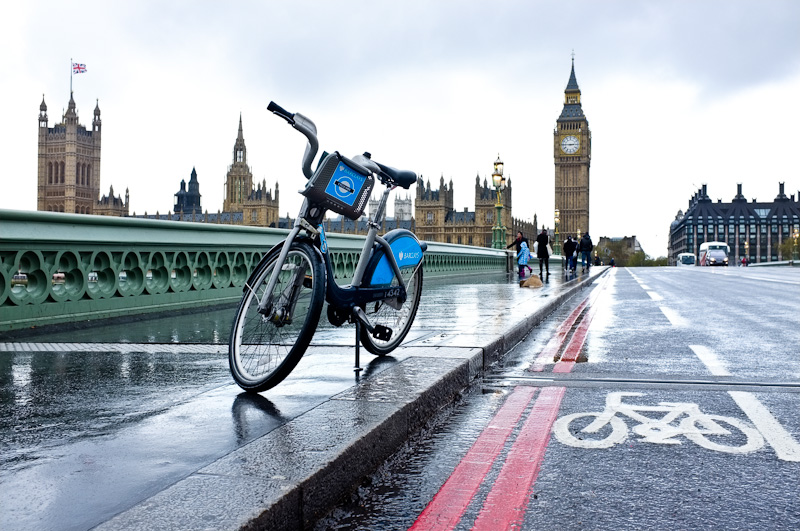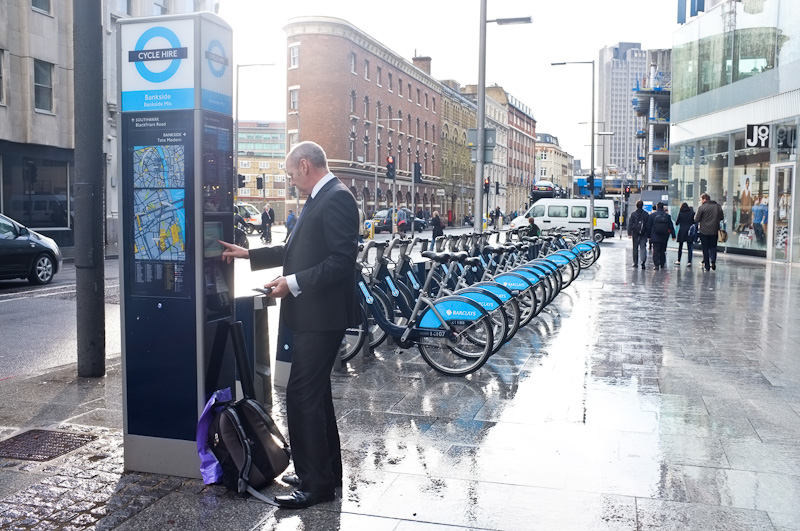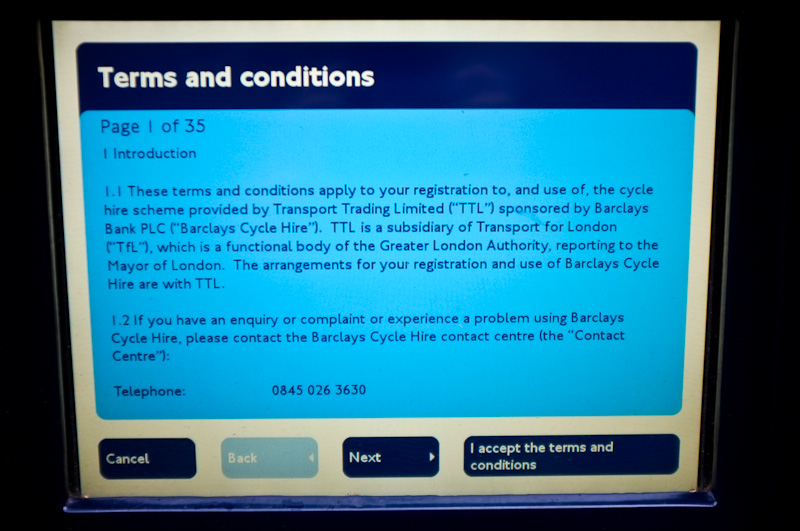
I got to spend a few days in London last week and was keen to try out their bike share system, Barclays Cycle Hire (commonly known as Boris Bikes, after mayor Boris Johnson). Partly because a bike is by far the best way to explore a city; party because New York will be coming out with its own bike share program this summer and I wanted to get a taste of the bike share goodness.
The London system currently has 8,000 bikes at 570 docking stations around London. The pricing structure strongly incentivizes short trips. Anything under 30 minutes is free. Prices rise sharply the longer you have a bike out. £1 for an hour, £4 for 90 minutes, and so forth. There are two kinds of memberships: an annual membership where you have your own fob key to unlock bikes, and a “casual use” basis where you just swipe your credit card at a docking station every time you want to take a bike out.

I had no idea what to expect when approaching a docking station for the first time. Turns out getting a bike is remarkably easy. You swipe your credit card and the system checks if you’re rented a bike before. I hadn’t, so the first thing I had to do was buy an access pass. £1 for a day, £5 for 7 days. Once you make the selection, you swipe your card again to initiate a rental period.


You click through some T&C, and voila! The machine prints out a slip of paper with a 5-digit access code to unlock a bicycle.

Within less than 5 minutes from first approaching the docking station, I was already unlocking a bike, ready to ride. At this point I had spent £5 for weekly access. If I kept all my trips to 30 minutes or less, I would not have to spend a penny more.
Once you’ve got your release code, it’s time to pick out a bike. Look over your options carefully before removing a bike. The most important things you can check for before unlocking a bike is seat adjustment and ti(y)re pressure.

The bikes themselves are built to be durable and safe. Which means they’re heavy and slow. But still – I had been in the UK for less than 2 hours and I was already on a bike! And that is pretty damn cool.

Off I went
When you’re ready to return a bike, you can dock it at any free docking point. How do you know where the docking stations are? There are multiple options to find this out. The terminals at the stations can show you surrounding docking stations. The Barclays Cycles website has a Google map of the city with an overlay listing all the docking station.

This map also gives you up-to-the-minute data on how many free bikes/docking points are at each station.

You can also download the Barclays Bikes app to your smartphone. This has the additional benefit of giving you routing directions.


As for the cycling experience in London, it’s a mixed bag. On the bike-friendliness scale, London is far from Amsterdam, Copenhagen, and even Berlin. But the city has definitely made an effort. Bicycle-specific signage is everywhere, and you often encounter bike lanes of various types. It largely depends on where you are. Sometimes biking in London looks like this:

Other times it looks like this:
 Or even this:
Or even this:
 On the whole, I found drivers to be quite courteous, especially given the high traffic density on many London streets. It took me a couple of days to get used to riding on the left, and even then I didn’t feel entirely confident with that aspect. Old instincts die hard, so I made sure to look in all directions and double-check the signals before crossing or turning at intersections.
On the whole, I found drivers to be quite courteous, especially given the high traffic density on many London streets. It took me a couple of days to get used to riding on the left, and even then I didn’t feel entirely confident with that aspect. Old instincts die hard, so I made sure to look in all directions and double-check the signals before crossing or turning at intersections.
Some more observations about bike share:
- If you arrive at a docking station that has no free docking points, you can use the terminal to get a free 15 minutes to return the bike to another nearby location.
- Bring a small towel along to wipe down your saddle after it rains. London weather lives up to its reputation. It rained about every hour for 3 days straight. In between showers it would get sunny. Absolutely insane.
- Barclays Bikes deploys teams of employees to relocate batches of bikes from busy stations to less busy ones, based on traffic patterns. At one point I found myself near King’s Cross St. Pancras station. There was a near-steady stream of people dropping off bikes, presumably on their way to catch a train. Without the 4-strong team of Boris Bikes workers unloading the bikes as soon as they came in, the station would have been full in 5 minutes.

Final thoughts:
The good:
- Renting a bike is super easy. All you need is a credit card – no need to register online or become a member at all
- Docking stations are pretty abundant. I almost never actively looked for one
- Most bikes are in pretty decent condition
- It’s cheap. If you keep your trips under 30 minutes each, all you pay is £1/day or £5/week access fee
- The bikes are pretty comfortable
- You’re exploring London on a bike! What could be better!
The not so good:
- There’s a fair share of bikes that are not in the best shape. I encountered a decent number of flat tires, sticky gears, etc.
- Bikes are heavy and slow (geared low). This is obviously by design, but can be frustrating if you’re in a hurry.
- There is no guarantee that a docking point will be free at your destination.
- The bells are super quiet and basically a joke
Overall, I loved the Boris Bikes experience. Nothing gives you a sense of a city like cycling through its neighborhoods. I didn’t find London to be the most bike-friendly of cities, but it wasn’t bad either. I just had to keep chanting to myself: Keep left! Keep left!
I’m more excited than ever for bike share to come to New York. Obviously I only experienced it as a tourist, but I think it will also be super useful for local commuters, especially those making short trips. One knock against it is that you’re not guaranteed to find a free dock at your destination, which could screw you up if you’re in a hurry. Then again, so can getting stuck in a cab in crosstown traffic, or underground on the subway during a mysterious “police action.” There are trade-offs in everything. The fact that New Yorkers will soon have this new transit option is absolutely brilliant.


NYCbiker - The backwards seat (probably) isnt a “fucked up saddle.” In Paris it is the un-written rule to turn around a seat if a bike has an issue, ie broken pedal, chain, or flat tire (the case for the one pictured), etc. However the seat may also have been broken. It aids the workers quickly identify bikes that need repair and allows bike renters to quickly see that a bike has an issue and to move onto the next.
Dmitry - Great point, thanks for sharing!
NYCbiker - Its something a friend informed me about the Paris system. Hopefully its something that picks up in NYC as well because it was very useful if you’re in a hurry and forget/miss something in a check before renting the bike out. But its a grass roots type of system.